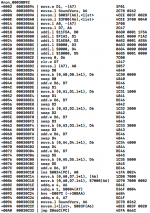Mu0n
Well-known member
If you're not familiar with Bogas Productions' 1986 Studio Session app, then check out this other thread I made:
Reverse-Engineer Goal: Load a Studio Session song file (along with its instruments) and play it back, close to the original in a custom game program (eg in an intro splash screen)
Target Platform: System 6 to probably System 4.2 (ish)
Development Environment: THINK C Manager (using Symantec C++ 6.0 which can deal with both C and ASM code blocks) under System 7.5.5 (emulated)
Group Effort?: if this is something that interests you and you have some keen programming knowledge in ASM and C, then that would be grand! I'm always looking for some tips too.
In 2004-2006, I wanted to:
1) increase my C/C++ programming skills
2) figure out a way to do game programming on my old Mac Plus machine
Back in the day (1986-1993), I only had access to the limiting Microsoft Basic 2.0 development platform. While great for learning programming fundamentals, it showed its limit in terms of fluid animation and sound playback fairly quickly. There were loads of ZX80, Spectrum and C64 programming books in my city's library, but very few for the Macintosh. I did have an introductory book with examples in Basic, but I was light years away from having the tools and examples necessary to do real development that approached the commercial stuff.
The goal was to use Studio Session to compose intro/ending music (with not much animation happening on screen) instead of writing a music engine from scratch. While I sadly found no code anywhere on the web, in the hotline retromac68k server or countless various FTPs. I did find a spec document written in 1993 by a MIT student who was interested by the very same challenge!
I was able to use his document somewhat to start gathering the global data of a song file. If I recall correctly, I might have been successful into recording a sound in a modern PC of that 2005 era, convert it a bunch of times into the sound file needed to create a new Studio Session Instrument. They are the same format as used by SoundCaps 4.2 (which can run in System 6 but not System 7).
Project Goals:
Phase 1: Simply interpret a song file and play one track back using the square-wave or one of the tracks from the four-tone synth, just to get pitch and tempo right (ie ditch instrument data and any track that's not #1)
Phase 2: Play up to 4 tracks under the four-tone synth
Phase 3: Mix the 6 potential tracks in the free-form synth - this will possibly involve on-the-fly mixing of wave data as the song is interpreted. This is the real challenge as you don't know in advance how the tracks go into activation or fade out, since the notes can be of various length and the sound files associated with each instruments have different lengths.
Here's the spec document in full:
View attachment Studio Session Song (.sss).txt
Reverse-Engineer Goal: Load a Studio Session song file (along with its instruments) and play it back, close to the original in a custom game program (eg in an intro splash screen)
Target Platform: System 6 to probably System 4.2 (ish)
Development Environment: THINK C Manager (using Symantec C++ 6.0 which can deal with both C and ASM code blocks) under System 7.5.5 (emulated)
Group Effort?: if this is something that interests you and you have some keen programming knowledge in ASM and C, then that would be grand! I'm always looking for some tips too.
In 2004-2006, I wanted to:
1) increase my C/C++ programming skills
2) figure out a way to do game programming on my old Mac Plus machine
Back in the day (1986-1993), I only had access to the limiting Microsoft Basic 2.0 development platform. While great for learning programming fundamentals, it showed its limit in terms of fluid animation and sound playback fairly quickly. There were loads of ZX80, Spectrum and C64 programming books in my city's library, but very few for the Macintosh. I did have an introductory book with examples in Basic, but I was light years away from having the tools and examples necessary to do real development that approached the commercial stuff.
The goal was to use Studio Session to compose intro/ending music (with not much animation happening on screen) instead of writing a music engine from scratch. While I sadly found no code anywhere on the web, in the hotline retromac68k server or countless various FTPs. I did find a spec document written in 1993 by a MIT student who was interested by the very same challenge!
I was able to use his document somewhat to start gathering the global data of a song file. If I recall correctly, I might have been successful into recording a sound in a modern PC of that 2005 era, convert it a bunch of times into the sound file needed to create a new Studio Session Instrument. They are the same format as used by SoundCaps 4.2 (which can run in System 6 but not System 7).
Project Goals:
Phase 1: Simply interpret a song file and play one track back using the square-wave or one of the tracks from the four-tone synth, just to get pitch and tempo right (ie ditch instrument data and any track that's not #1)
Phase 2: Play up to 4 tracks under the four-tone synth
Phase 3: Mix the 6 potential tracks in the free-form synth - this will possibly involve on-the-fly mixing of wave data as the song is interpreted. This is the real challenge as you don't know in advance how the tracks go into activation or fade out, since the notes can be of various length and the sound files associated with each instruments have different lengths.
Here's the spec document in full:
View attachment Studio Session Song (.sss).txt
Last edited by a moderator:

